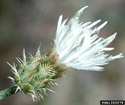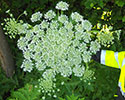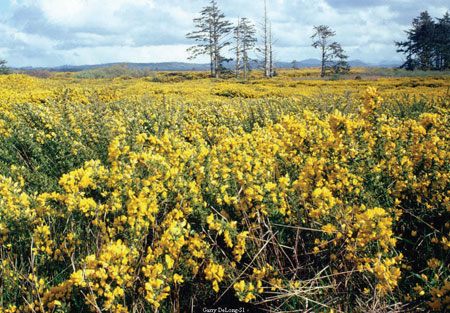
Common Fennel |
-
Licorice scented perennial 4-10 ft. tall
-
Leaves are dark green and feathery
-
Umbrella shaped clusters of small yellow flowers
-
Tap roots can reach depths of 10 feet
-
Outcompetes native plants and reduces native wildlife habitat
-
Once established it is difficult to control, due to strong competitive abilities and persistent seed bank
|
|
|

Dalmation Toadflax |
-
Perennial herb 2.5 to 5 feet tall
-
Waxy, heart shaped, light green leaves
-
Bright yellow flowers tinged with orange center, looks like a snapdragon
-
Persistent, aggressive invader, pushes out native grasses and other perennials
-
Rapidly colonizes open sites
-
Contains poisonous alkaloid, toxic to livestock
|
|
|

Wild Chervil
|
-
Biennial plant grows from 1 to 4 ft. tall
-
Hollow ridged stems with fern-like leaves
-
Small, white umbrella shaped flower clusters
-
Serious threat to native plants and agriculture
-
Highly adaptable, will grow in almost any type of soil
-
Has an aggressive growth habit, quickly creates a monoculture
-
Most of Pierce County is highly susceptible to Wild Chervil infestation
|
|

Tansy Ragwort
|
-
Invasive, persistent, toxic biennial
-
1st year: rosette stage; dark green basal leaves, ruffled in appearance
-
2nd year: one or more flowering stalks bolt up to 6 ft. tall
-
Numerous yellow, daisy-like, flowers with 13 petals
-
Contains toxins that cause chronic irreversible liver damage; a threat to livestock and agriculture.
|
|
 Poison Hemlock Poison Hemlock
|
-
Toxic biennial plant up to 10 ft. tall
-
1st year: basal rosette with fern like leaves.
-
2nd year: produces hollow, hairless stems with purplish splotches and dark green, glossy, fern-like leaves
-
Umbrella shaped clusters of small, white flowers
-
All plant parts are extremely poisonous to humans and livestock
-
Wear gloves and protective clothing when handling this plant, can cause contact dermatitis
-
Do not burn or compost this plant
|
|

Knapweeds
|
-
There are 3 species of knapweed that threaten Pierce County: spotted, diffuse, and meadow knapweed
-
1st year: rosettes form
-
2nd year: flowering stalks elongates
-
Spine tipped, or fringed bracts (leaf-like structure at the base of the flower)
-
Flowers are lavender to pink and sometimes white
-
Very aggressive species, one of the most dominant weeds of the west, can infest large areas very quickly
-
Contains phyto-toxins which inhibit the growth of surrounding native plants, allowing knapweed to form monocultures
-
Has very long tap roots
|
|
|

Gorse |
-
A dense, spiny, evergreen shrub, 3-10 ft. tall, closely resembles scotch broom
-
Aggressive, invasive plant crowds out other vegetation, forms dense thickets
-
Has sharp thorn-like leaves up to 3 in. long
-
Clusters of bright yellow, pea-like flowers form into pods containing 1 to 4 seeds
-
Plants form a center of dry, dead vegetation, that coupled with its high oil content creates a serious fire hazard
|
|
|

Perennial Pepperweed |
-
Bushy, perennial plant usually1 to 3 ft. tall, but may reach up to 6 ft.
-
Alternate, waxy leaves with white mid-vein
-
Rounded clusters of small white flower at branch tips
-
Displaces desirable native plants
-
Poses serious threat to natural areas, wildlife habitat, pastures, and coastal areas
-
Destabilizes river and stream banks, increases soil erosion
|
|
|

Giant Hogweed |
-
Huge perennial plant from15-20 ft. tall.
-
Hairy, hollow stems 2 to 4 in. in diameter, with dark reddish, purple splotches
-
Large compound leaves, up to 5 ft. wide with jagged edges
-
White umbrella shaped, flower-heads up to up to 2.5 ft. wide
-
Clear watery sap causes ultraviolet skin sensitivity, resulting in severe burns, blisters and scars
-
Sap can squirt up to 5 ft. when stem is cut or broken.
-
Do not handle without gloves, goggles and protective clothing
|
|
|

Shiny Geranium |
-
Low growing annual, 10 to 12 inches high
-
Stems are tinged bright red
-
Leaves are rounded, divided into lobed sections that have 3 lobes at the tip and are shiny and bright green, turning red in late summer and fall
-
Pink flowers grow in pairs and have 5 petals
-
Invades woodlands, forest openings, open grasslands and native habitat
|
|
|










